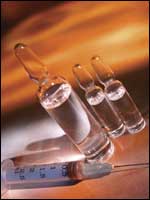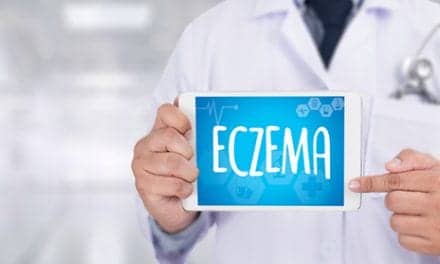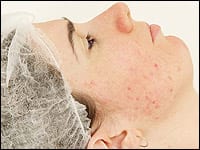 |
The adage that more isn’t necessarily better still holds true in some arenas. However, in aesthetic medicine, creating a combination regimen that delivers the appropriate spectrum of treatments is an art form. Many patients who lack the time and money to invest in more expensive and complex surgical rejuvenation procedures prefer the boon of less-invasive therapies that are currently at their surgeons’ disposal.
Botulinum toxin Type A (BTTA) is at the forefront of the combination therapy trend. Antiaging and skin-refining treatments are constantly evolving, and surgeons are coming up with more ways to combine BTTA with other treatments.
BTTA and fillers are often used in tow, first to create a smoother skin surface by preventing muscle contraction, and then to add volume to specific areas of the face. Likewise, thicker filling agents are injected deeper into the skin to restore facial volume. If a patient has deep static furrows that persist even at rest, BTTA can provide a vast improvement.
A combination of toxins and dermal fillers can offer longer-lasting improvement than either substance used alone. They work in tandem to maximize the aesthetic benefits, increase the time between touch-ups, and optimize the effects. They also can be combined with nonsurgical lifting systems such as radiofrequency or IR devices.
BTTA as a Baseline
Treatments that improve the quality and texture of the skin will make the BTTA and filler effects more striking. If you are considering laser facial rejuvenation, such as one that uses intense pulsed-light (IPL) therapy, BTTA is a great complement. A secondary toxin effect results in improvement greater than that achieved by BTTA or IPL treatment alone.
IPL is frequently used to effectively treat skin conditions that include broken capillaries, redness, rosacea, brown spots, and skin texture. Similarly, BTTA appears to enhance the skin-texture improvement achieved with nonablative lasers as well. BTTA also shows promise for augmenting the effects of nonthermal, nonablative photomodulation using LEDs.
In many practices, injecting BTTA into specific areas 1 to 2 weeks before performing laser resurfacing is standard operating procedure. This provides the opportunity for additional adjustments, if necessary, before the laser-resurfacing procedure. Its effect is crucial during the period of collagen remodeling.
“If I am treating someone with [fractional resurfacing] laser rejuvenation and they have got intense frown lines or smile lines, and I can reduce those with botulinum toxin before doing the laser, it helps rejuvenate the skin into a much smoother state,” says Bryan G. Forley, MD, a plastic surgeon in private practice in New York City.
Laser resurfacing of the eyelids or face can tighten and lift the skin by removing wrinkles and creating new collagen. If the eyelid and facial muscles are relaxed with BTTA while the new collagen is forming, the result is even more enhanced. On the other hand, if the eyelid and facial muscles have not been relaxed with neuromodulators before the formation of new collagen begins, and these muscles are in constant movement, it is widely accepted that the new collagen may not be as smooth.
For example, for the brow area, surgeons can partially elevate the brow using BTTA. However, if they also treat patients with skin-tightening devices to tighten the forehead, a better result may be achieved in one session. Likewise, some surgeons choose to pretreat with BTTA 2 weeks before performing a skin-tightening or threadlift procedure.
In theory, relaxing the muscles that depress the brow and the lower face decreases resistance to collagen contraction and allows more efficient collagen remodeling. This can also be supplemented with IPL and dermal fillers.
Combining Dermal Fillers
“The key to fillers is to define where you need volume and where you need structure,” says Patricia Wexler, MD, a dermatologist in private practice in New York City.
Offering dermal fillers and BTTA has emerged as the most popular and reliable way to jump-start an aesthetic practice. Their effectiveness, low morbidity, and predictable, reproducible results have made these treatments well-accepted among physicians of all specialties. Dermal fillers to treat lines and rhytides are all important components of this new combination armamentarium.
Hyaluronic acid represents the largest group of currently available dermal fillers. “Achieving success with dermal fillers lies in knowing which product best corrects a particular problem, and how and when to intervene if adverse events occur,” says Steven Fagien, MD, an oculoplastic surgeon in Boca Raton, Fla. “Each product has its own unique qualities and may require specific techniques to achieve optimal results.
“They also vary regarding the level of pain upon injection, ease of use, best location of injection into the skin, duration of results, as well as potential side effects,” he continues. “You need to have a clear understanding of which substance is best suited to address a particular defect.”
Topicals and Light-Based Devices
The new generation of laser and nonlaser light devices, including IPL devices, has been proven to offer substantial improvements in vascular conditions, rosacea, photodamage, and stimulating dermal collagen production, without damaging the epidermis. Although surgeons and patients are often quick to welcome new technologies, their expectations for results continue to climb.
Patients are seeking significant improvements, but they are not content to readily accept downtime, expense, and treatment frequency. Therefore, any treatment that can improve results without adding significantly to the side effects, redness, or cost is more likely to be embraced.
The combination of light therapies and topical agents can increase the efficacy of each of these procedures and can also help with maintenance after and between treatments. Light-based therapies have been an important addition to the antiacne armamentarium because they are effective and do not add to the increasing bacterial-resistance problem.
We are seeing a trend toward the acceptance of combination treatments that pair nonablative lasers—such as IPL, pulsed-dye lasers, 1320-nm lasers, and LED therapy—with topical medications. The pharmaceutical treatments that are commonly used in conjunction with these devices include topical retinoids for acne, actinic damage, and lentingines. New indications are being added continually.
Fat and volumizing fillers also offer multiple advantages when combined with other techniques, including skin-tightening devices and threadlifts. “I use poly(l-lactic acid) to sculpt the face,” says Stephen Mandy, MD, a dermasurgeon in Miami Beach, Fla. “If you do that about 6 weeks before a threadlift, you have new collagen that has just been laid down, and collagen synthesis helps cement the flap elevation in place.”
Selecting the ideal skin-treatment system for home use is essential for maximizing in-office treatments. The better shape the patient’s skin is in, the greater the effect will be with other noninvasive therapies. Table 1 summarizes the combination treatments I have discussed.
|
Table 1. The Spectrum of Combination Treatments |
|
|
Combination Therapy |
Results |
|
BTTA with dermal fillers |
Combines the treatment of wrinkles due to expression (dynamic) as well as those due to loss of connective tissue (static). More complete and long-lasting effect than either treatment by itself. |
|
BTTA with IPL |
Improves skin surface while addressing the dynamic source of many facial wrinkles, and BTTA enhances the effect of IPL treatments. |
|
IPL with microdermabrasion |
Combines strategies to superficially resurface and tone the outer layers of skin with minimal downtime and risk. Using microdermabrasion the day after IPL speeds up the clearing of mottled pigmentation. |
|
Microdermabrasion with peels |
Both address the outer layers of skin and polish it with different methods—harnessing chemical and mechanical techniques for improving outer skin appearance. Performing microdermabrasion first enhances the depth of the peel. |
|
Dermal fillers with IPL or photodynamic therapy |
Dermal fillers are used to restore volume to the face, while IPL or PDT is used to tone and refine the texture of the outer layers of skin and improve its appearance. |
Benefits in Darker Skin Types
Virtually any inflammatory process or skin problem such as acne or eczema can cause postinflammatory hyperpigmentation (PIH). “That is why nearly 100% of the people of color who walk into my office have some form of PIH, even if it’s not their primary complaint,” says Fran Cook-Bolden, MD, a dermatologist in private practice in New York City. As for treatments, hydroquinone has been the mainstay for more than 50 years.
“It still remains the basis of therapy,” she says. “However, in recent years, there’s been a revolution of combination hydroquinone therapies that include things like glycolic acids, retinoids, antioxidants, and sunblocks. Right now, the best and most effective treatments are the combination treatments.”
 |
| See also “Skin Tightening” by Dierdre S. Leake, MD, and Janine L. Ellenberger, MD, in the March 2006 issue of PSP. |
Other agents used in combination therapies include tretinoin and retinols, glycolic acid, and topical steroids, which can help prevent irritation from hydroquinones and tretinoins while possessing intrinsic lightening properties. For maximum efficacy, combining topical treatments with exfoliation, chemical peels, microdermabrasion, dermabrasion, and lasers is considered the ideal to speed up skin-lightening results.
“The scope of aesthetic medicine is expanding, and the future lies in integrating procedures to produce the best outcomes for patients,” Mandy says. “The synergy concept is that 1 + 1 = 10.”
Wendy Lewis is a contributing writer for Plastic Surgery Products; author of America’s Top Cosmetic Doctors (Castle Connolly); and the editorial director for MDPublish.com, a medical marketing and publishing group. She can be reached via her Web site, www.wlbeauty.com.




